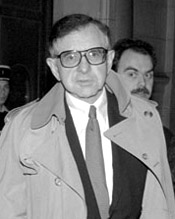(Dr. Nathanson was one of the founding members of the National Association for the Repeal of Abortion Laws, now known as NARAL Pro-Choice America.)
In 1970, Dr. Bernard Nathanson, the son of a distinguished medical doctor, began running the Center for Reproductive and Sexual Health in New York City. In addition to performing and giving supervision to thousands of abortions, he became a zealous crusader and campaigner for the legalization of abortion. He and his colleagues argued before voters, lawmakers, and judges that laws against abortion were worse than futile and thus should be opposed. He confessed later that they lied, boldly and relentlessly, about the number of women who died each year from illegal abortions—claiming the number was more than ten times higher than it actually was. In 1973, he left the Center to become chief of obstetrical services at St. Luke’s Hospital Center, but he continued doing abortions. While there, however, he discovered the latest in fetal technology—the ultrasound machine. It opened the window for him on fetal development. His personal struggle began.
By 1974, he penned a widely noticed article in the prestigious New England Journal of Medicine. In the article, he revealed his growing doubts about the popular view that abortion was merely the removal of an “undifferentiated mass of cells,” and not the killing of a developing human being. In abortion, he wrote,
“We are taking life, and the deliberate taking of life…is an inexpressibly serious matter.”
By 1979, Nathanson had become convinced that what was developing within the womb was, indeed, human life, from the very onset of pregnancy. This emerging conclusion was devastating for him to face personally. Referring to abortions he had either performed or supervised, he confessed to an “increasing certainty that I had in fact presided over 60,000 deaths.” In 1979, he authored (along with Richard N. Ostling, a prominent journalist with  Christianity Today and Time) his first book, Aborting America. The impact of this stunning new conviction took him out of the practice of abortion. Before long, he came to regard the procedure as an unjustified homicide. In the early 1980s, he dedicated himself to the fight against abortion, the procedure for which he was once its most influential advocate, especially to persons of influence in high places. In 1985, using the new fetal imaging technology, he produced the documentary film, “The Silent Scream,” which went viral in the pro-life movement in America.
Christianity Today and Time) his first book, Aborting America. The impact of this stunning new conviction took him out of the practice of abortion. Before long, he came to regard the procedure as an unjustified homicide. In the early 1980s, he dedicated himself to the fight against abortion, the procedure for which he was once its most influential advocate, especially to persons of influence in high places. In 1985, using the new fetal imaging technology, he produced the documentary film, “The Silent Scream,” which went viral in the pro-life movement in America.
Thankfully, his story does not end here. All of this happened while he was an irreligious, atheistic Jew. His argument against abortion was not, he always insisted, religious in nature. It was based on science and principles of the rights and dignity of human beings. He was thoroughly secular. He had been married three times. Living an “unspeakably shallow” life, he described himself as materialistic and ruthlessly ambitious. While attending a pro-life rally in New York City in 1989, he saw something that began to break through his long-held religious defenses. He saw, in his words, “an intensity of love and prayer that astonished me.” He went on to confess that, on that day, he began “for the first time in my entire adult life…to entertain seriously the notion of God.”
– this is an excerpt from the sermon:
by Dr. James V. Heidinger II
